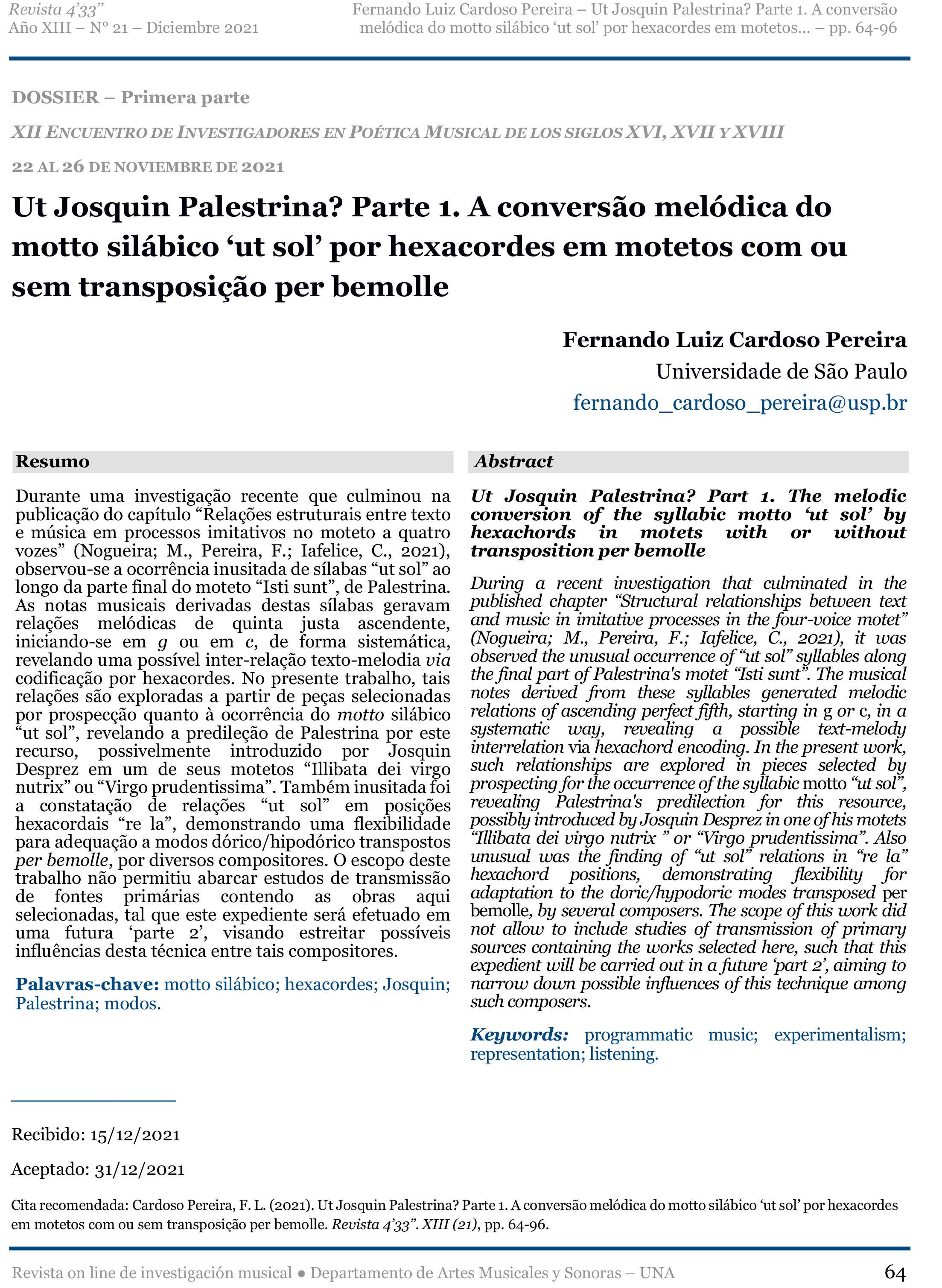Ut Josquin Palestrina? Parte 1. A conversão melódica do motto silábico ‘ut sol’ por hexacordes em motetos com ou sem transposição per bemolle
Palavras-chave:
motto silábico, hexacordes, Josquin, Palestrina, modos, programmatic music, experimentalism, representation, listeningResumo
Durante uma investigação recente que culminou na publicação do capítulo “Relações estruturais entre texto e música em processos imitativos no moteto a quatro vozes” (Nogueira; M., Pereira, F.; Iafelice, C., 2021), observou-se a ocorrência inusitada de sílabas “ut sol” ao longo da parte final do moteto “Isti sunt”, de Palestrina. As notas musicais derivadas destas sílabas geravam relações melódicas de quinta justa ascendente, iniciando-se em g ou em c, de forma sistemática, revelando uma possível inter-relação texto-melodia via codificação por hexacordes. No presente trabalho, tais relações são exploradas a partir de peças selecionadas por prospecção quanto à ocorrência do motto silábico “ut sol”, revelando a predileção de Palestrina por este recurso, possivelmente introduzido por Josquin Desprez em um de seus motetos “Illibata dei virgo nutrix” ou “Virgo prudentissima”. Também inusitada foi a constatação de relações “ut sol” em posições hexacordais “re la”, demonstrando uma flexibilidade para adequação a modos dórico/hipodórico transpostos per bemolle, por diversos compositores. O escopo deste trabalho não permitiu abarcar estudos de transmissão de fontes primárias contendo as obras aqui selecionadas, tal que este expediente será efetuado em uma futura ‘parte 2’, visando estreitar possíveis influências desta técnica entre tais compositores.
ABSTRACT
Ut Josquin Palestrina? Part 1. The melodic conversion of the syllabic motto ‘ut sol’ by hexachords in motets with or without transposition per bemolle
During a recent investigation that culminated in the published chapter “Structural relationships between text and music in imitative processes in the four-voice motet” (Nogueira; M., Pereira, F.; Iafelice, C., 2021), it was observed the unusual occurrence of “ut sol” syllables along the final part of Palestrina's motet “Isti sunt”. The musical notes derived from these syllables generated melodic relations of ascending perfect fifth, starting in g or c, in a systematic way, revealing a possible text-melody interrelation via hexachord encoding. In the present work, such relationships are explored in pieces selected by prospecting for the occurrence of the syllabic motto “ut sol”, revealing Palestrina's predilection for this resource, possibly introduced by Josquin Desprez in one of his motets “Illibata dei virgo nutrix ” or “Virgo prudentissima”. Also unusual was the finding of “ut sol” relations in “re la” hexachord positions, demonstrating flexibility for adaptation to the doric/hypodoric modes transposed per bemolle, by several composers. The scope of this work did not allow to include studies of transmission of primary sources containing the works selected here, such that this expedient will be carried out in a future ‘part 2’, aiming to narrow down possible influences of this technique among such composers.


